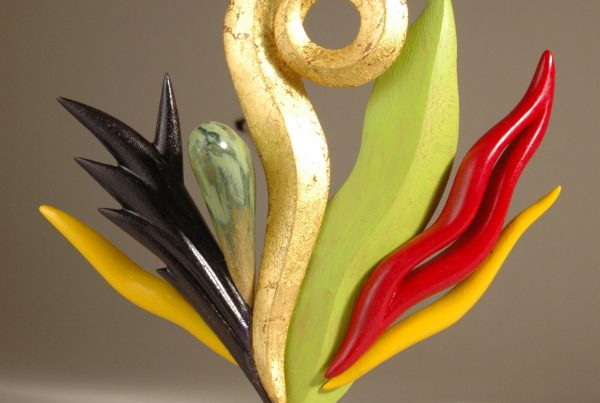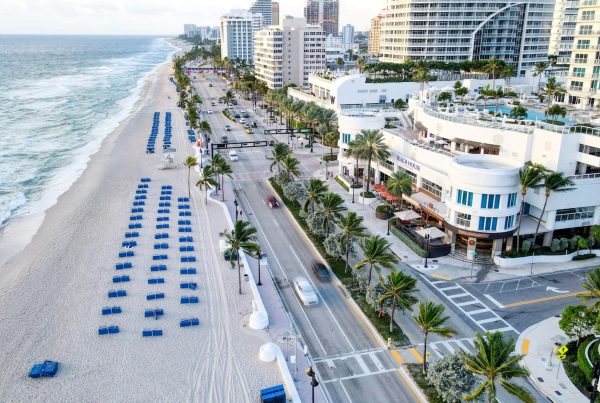I honestly cannot remember the last time I felt giddy just driving a past a building.
The Norton Museum of Art, which finally opened to the public this month after a $100 million renovation and expansion, did this to me. My heart skipped a couple of beats, and I probably held up traffic, as I drove past the now-enormous edifice, missing the entrance to the new parking lot across the street. I didn’t care; I could U-turn and gaze at it once more. I was a child again, about to enter Disney World.
This level of anticipation was not exaggerated. As I was about to discover, whatever notions I held about how impressive the new Norton would be—formed after seeing countless renderings, and interviewing the principal players for a feature in the current issue of Boca magazine—needed to be upgraded tenfold. Simply put, you can believe the hype, and then some.
The transformation begins outside, with the sleek new entrance façade that wraps around the historic banyan tree. A tranquil water feature reflects off the metal roof, and sitting in the pool is a permanent sculpture, Claes Oldenburg’s colossal “Typewriter Eraser, Scale X”—a tilting, funky monolith that establishes the Norton’s contemporary art bona fides before you step foot in the building.
Inside, I was immediately struck by the sheer number of visitors at 2 p.m. on a Tuesday. I had to wait in a sizable queue just to pick up my ticket—a first in all my years at the Norton. The capacious Great Hall to the left of the ticket counter was abuzz with people lounging on the modernist chairs, ordering from the (reasonably priced!) coffee bar, perusing supplied catalogs from the Norton archive during downtime. As I continued exploring the building, a tour commenced, and dozens of guests clustered around a docent, rapt by every word. The new full-service restaurant was equally jammed, with hardly a free table in sight.
In its previous incarnation, which now seems like a thousand years ago, the Norton was not particularly engaging aesthetically, and after I while I took it for granted. I would pop in, review specific exhibitions—which were almost always of an exceptional quality—and leave the premises, paying little mind to the spaces between.
This time, I’ll be putting aside my old method of breaking down an exhibition in granular detail. To focus on the individual trees when the forest is so mind-blowing seems to be missing the point. Instead, here are my observations about the overall experience.
- Give yourself a day to see everything. Treat the experience like a trip to the Met, or to MoMA, or to the Louvre. You’ll need all that time and more.
- Many of the galleries are awash in natural light, part of the architects’ vision to connect the Norton with the outside world. The appeal of this decision on the viewing of art is immeasurable.

- The galleries flow like never before. In the older design, not only did space prohibit many important art movements from being represented in the permanent collection, but they were segmented at opposite sides of the museum, separate from special exhibitions. Now, the Norton is a three-story maze of art, with the museum’s collections wending beautifully into temporary exhibition space and back again. With more work on display now than ever—from Baroque, Rococo and Neoclassicism to Abstract Expression, Pop Art and contemporary—a visit to the Norton could fill an Art 101 textbook.

- There is no wasted space; impressive art is everywhere you look—from the wraparound gold-leaf mural in the private events room to the commissioned tapestry in the Great Hall to Rob Wynne’s “I Remember Ceramic Castles, Mermaids and Japanese Bridges,” a site-specific glass-art installation of more than 6,000 individual pieces, which runs along the length of the staircase.

- Speaking of glass art, Dale Chihuly’s “Persian Sealife” ceiling-mounted collage of 693 pieces of priceless blown glass, has been reassembled and re-hung, and it’s even more stunning here than in its previous incarnation.

- The Norton has long held one of the most in-depth collections of Chinese art in the Southeast, and with galleries on two floors devoted to it, more of these extraordinary artifacts are on display. Housed in specially designed cases imported from Quebec, under reverent lighting, 460 of these masterpieces constitute a celebratory connection to both history and art. Don’t miss the six-panel “Good Fortune to All,” a sprawling series of paintings of a Ming dynasty lantern festival—which was acquired by the Norton in 2015 and then painstakingly resorted.

- The outdoor sculpture gallery, segmented into “pocket galleries” of kinetic, abstract and whimsical works, is a tranquil garden walk, lined with verdant plants hand-picked by the architects. No visit to the Norton is complete without a visit.

- Compelling temporary exhibitions on display include “WHO? A Brief History of Photography Through Portraiture,” which showcases varied approaches to the portrait, from street photographs to celebrity magazine shoots; “Modern Spontaneity: Ralph Norton’s Watercolor Collection,” a rare assemblage of the delicate, light-sensitive works; and my favorite of the bunch, Nina Chanel Abney’s “Neon,” a series of 2019 paintings from this sly and confrontational artist, whose surreal graphic circuses double as potent commentaries on gender and race.
Basically, it’s all great. You need to go. Now.
The Norton Museum of Art is at 1450 S. Dixie Highway, West Palm Beach. Admission costs $18 adults, $15 seniors (60 and up), $5 for students and free for children 12 and younger, teachers and active military. Admission is free to all visitors on Fridays and Saturdays. For information, call 561/832-5196 or visit norton.org.







